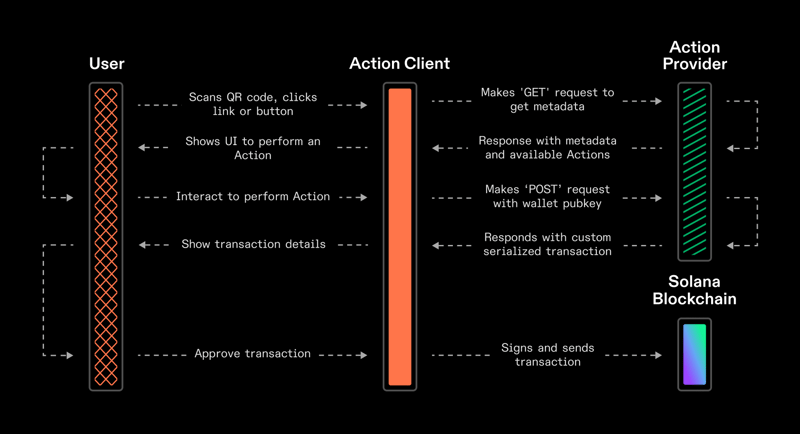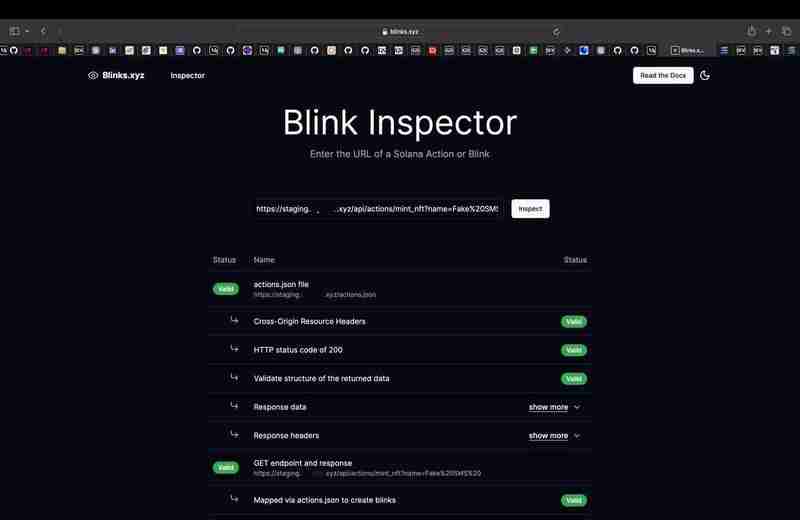Solana Blinks with Go
Blinks are metadata-rich links that represent and enable on-chain activities throughout the Solana ecosystem without needing to navigate to a different app or webpage.
Blinks supports a wide range of activities enabled by Solana Actions
and primarily allow users to interact with the blockchain through social media and other off-chain platforms.
Use-Cases include:
- NFT trading & minting,
- Donations,
- Crowd funding,
- Token swaps,
- Lottery/Casino apps and much more
In this article, we shall explore a simple Blink app focused on minting NFTs using Go. Whilst the article is Go focused, the core concepts apply to any Blink app. You can find the complete code on GitHub.
We'll begin by setting up a basic web server using the Gin framework, along with the necessary CORS configuration as defined by the specification. Also we’ll define some endpoints that will be discussed in detail below.
func main() {
var (
corsConfig = cors.DefaultConfig()
router = gin.Default()
port = os.Getenv("PORT")
)
corsConfig.AllowAllOrigins = true
corsConfig.AddAllowHeaders([]string{"Content-Length", "Content-Type", "Access-Control-Allow-Origin"}...)
corsConfig.AddAllowMethods([]string{"GET", "POST", "OPTIONS"}...)
router.Use(cors.New(corsConfig))
router.GET("/actions.json", app.ActionsRulesHandler)
router.GET("/api/actions/mint_nft", app.GetActionsHandler)
router.OPTIONS("/api/actions/mint_nft", app.OptionsHandler)
router.POST("/api/actions/mint_nft", app.PostHandler)
log.Println("StickyLabs Blink Active ?")
if port == "" {
port = "8081"
}
log.Println("Server is running")
err := router.Run(fmt.Sprintf(":%v", port))
if err != nil {
log.Fatal(err)
return
}
}
The core of any Blinks application lies in replicating the Solana Actions API Spec. Below is a visual representation of how Blinks work.

Action Handlers
Blinks on Solana uses an Action URL scheme to provide a metadata-rich link, enabling various on-chain activities. This section outlines the primary handlers responsible for processing the mint NFT action on the /api/actions/mint_nft
- GET Handler : Returns Metadata, supported actions and required parameters.
type ActionGetResponse struct {
Title string `json:"title"`
Icon string `json:"icon"`
Description string `json:"description"`
Label string `json:"label"`
Links struct {
Actions []Actions `json:"actions"`
} `json:"links"`
}
type Actions struct {
Label string `json:"label"`
Href string `json:"href"`
Parameters []ActionParameters `json:"parameters,omitempty"`
}
type ActionParameters struct {
Name string `json:"name"`
Label string `json:"label"`
Required bool `json:"required"`
}
func GetActionsHandler(c *gin.Context) {
payload := ActionGetResponse{
Title: "Actions Example - Mint NFT",
Icon: c.Request.URL.Scheme + "://" + c.Request.URL.Host + "/solana_devs.jpg",
Description: "Transfer SOL to another Solana wallet",
Label: "Transfer",
}
payload.Links.Actions = []Actions{
{"Mint NFT", "/api/actions/mint_nft", []ActionParameters{
{"name", "Enter the Name of the NFT", true},
{"symbol", "Enter the Symbol of the NFT", true},
{"uri", "Enter the Uri of the NFT", true},
}},
}
c.JSON(http.StatusOK, payload)
}
- OPTIONS : The OPTIONS handler handles CORS requirements, ensuring compatibility with browsers and other client request mechanisms.
var ACTIONS_CORS_HEADERS = map[string]string{
"Access-Control-Allow-Origin": "*",
"Access-Control-Allow-Methods": "GET,POST,OPTIONS",
"Access-Control-Allow-Headers": "Content-Type",
}
func OptionsHandler(c *gin.Context) {
for key, value := range ACTIONS_CORS_HEADERS {
c.Header(key, value)
}
c.Status(http.StatusOK)
}
- POST Handler :The POST handler accepts query parameters, parses the account in base58 provided as JSON, and returns a base64-encoded serialized transaction along with a message for the user to sign and execute.
type MintNFTParams struct {
Name string `form:"name" binding:"required"`
Symbol string `form:"symbol" binding:"required"`
URI string `form:"uri" binding:"required"`
}
// { "account": "<account>" } //JSON
type ActionPostRequest struct {
Account string `json:"account"`
}
type ActionPostResponse struct {
Fields ActionPostResponseFields `json:"fields"`
}
type ActionPostResponseFields struct {
Transaction string `json:"transaction"`
Message string `json:"message"`
}
func PostHandler(c *gin.Context) {
var (
qPayload MintNFTParams
request ActionPostRequest
response ActionPostResponse
)
if err := c.ShouldBindQuery(&qPayload); err != nil {
c.JSON(http.StatusBadRequest, ActionError{Message: "Invalid Query Params"})
return
}
if err := c.ShouldBindJSON(&request); err != nil {
log.Println(err)
c.JSON(http.StatusBadRequest, ActionError{Message: "Invalid request"})
return
}
account, err := types.AccountFromBase58(request.Account)
if err != nil {
log.Println(err)
c.JSON(http.StatusBadRequest, ActionError{Message: "Invalid request; Error validating account"})
return
}
response.Fields.Transaction, response.Fields.Message = mintNFT(qPayload, account)
c.JSON(http.StatusOK, response)
}
- Minting NFTs
The mintNFT function leverages Solana-Go-SDK for minting NFTs, with few adjustments.
func mintNFT(metadata MintNFTParams, feePayer types.Account) (transaction, message string) {
message = fmt.Sprintf("Mint NFT %s", metadata.Name)
c := client.NewClient(rpc.DevnetRPCEndpoint)
log.Println(metadata)
mint := types.NewAccount()
fmt.Printf("NFT: %v\n", mint.PublicKey.ToBase58())
collection := types.NewAccount()
fmt.Printf("collection: %v\n", collection.PublicKey.ToBase58())
ata, _, err := common.FindAssociatedTokenAddress(feePayer.PublicKey, mint.PublicKey)
if err != nil {
log.Fatalf("failed to find a valid ata, err: %v", err)
}
tokenMetadataPubkey, err := token_metadata.GetTokenMetaPubkey(mint.PublicKey)
if err != nil {
log.Fatalf("failed to find a valid token metadata, err: %v", err)
}
tokenMasterEditionPubkey, err := token_metadata.GetMasterEdition(mint.PublicKey)
if err != nil {
log.Fatalf("failed to find a valid master edition, err: %v", err)
}
mintAccountRent, err := c.GetMinimumBalanceForRentExemption(context.Background(), token.MintAccountSize)
if err != nil {
log.Fatalf("failed to get mint account rent, err: %v", err)
}
recentBlockhashResponse, err := c.GetLatestBlockhash(context.Background())
if err != nil {
log.Fatalf("failed to get recent blockhash, err: %v", err)
}
tx, err := types.NewTransaction(types.NewTransactionParam{
Signers: []types.Account{mint, feePayer},
Message: types.NewMessage(types.NewMessageParam{
FeePayer: feePayer.PublicKey,
RecentBlockhash: recentBlockhashResponse.Blockhash,
Instructions: []types.Instruction{
system.CreateAccount(system.CreateAccountParam{
From: feePayer.PublicKey,
New: mint.PublicKey,
Owner: common.TokenProgramID,
Lamports: mintAccountRent,
Space: token.MintAccountSize,
}),
token.InitializeMint(token.InitializeMintParam{
Decimals: 0,
Mint: mint.PublicKey,
MintAuth: feePayer.PublicKey,
FreezeAuth: &feePayer.PublicKey,
}),
token_metadata.CreateMetadataAccountV3(token_metadata.CreateMetadataAccountV3Param{
Metadata: tokenMetadataPubkey,
Mint: mint.PublicKey,
MintAuthority: feePayer.PublicKey,
Payer: feePayer.PublicKey,
UpdateAuthority: feePayer.PublicKey,
UpdateAuthorityIsSigner: true,
IsMutable: true,
Data: token_metadata.DataV2{
Name: metadata.Name,
Symbol: metadata.Symbol,
Uri: metadata.URI,
SellerFeeBasisPoints: 100,
Creators: &[]token_metadata.Creator{
// tODO rede && Minter
{
Address: feePayer.PublicKey,
Verified: true,
Share: 100,
},
},
Collection: &token_metadata.Collection{
Verified: false,
Key: collection.PublicKey,
},
Uses: nil,
},
CollectionDetails: nil,
}),
associated_token_account.Create(associated_token_account.CreateParam{
Funder: feePayer.PublicKey,
Owner: feePayer.PublicKey,
Mint: mint.PublicKey,
AssociatedTokenAccount: ata,
}),
token.MintTo(token.MintToParam{
Mint: mint.PublicKey,
To: ata,
Auth: feePayer.PublicKey,
Amount: 1,
}),
token_metadata.CreateMasterEditionV3(token_metadata.CreateMasterEditionParam{
Edition: tokenMasterEditionPubkey,
Mint: mint.PublicKey,
UpdateAuthority: feePayer.PublicKey,
MintAuthority: feePayer.PublicKey,
Metadata: tokenMetadataPubkey,
Payer: feePayer.PublicKey,
MaxSupply: pointer.Get[uint64](0),
}),
},
}),
})
if err != nil {
log.Fatalf("failed to new a tx, err: %v", err)
}
serialized, err := tx.Serialize()
if err != nil {
log.Fatal(err)
}
transaction = base64.StdEncoding.EncodeToString(serialized)
return
}
- Error Handling: Actions should return user friendly errors in the format below.
// { "message" : "Insert Error Message" } //JSON
type ActionError struct {
Message string `json:"message"`
}
- actions.json: The actions.json file should be stored at the root of the domain. It provides instructions to clients on what URLs support Solana Actions and provide mappings that can be used to perform GET requests to the Blink app. For simplicity we would be returning a JSON response from the url path
func ActionsRulesHandler(c *gin.Context) {
payload := gin.H{
"rules": []gin.H{
{
"pathPattern": "/*",
"apiPath": "/api/actions/*",
},
{
"pathPattern": "/api/actions/**",
"apiPath": "/api/actions/**",
},
},
}
c.JSON(http.StatusOK, payload)
}
Testing your Blink
After deploying your app, you could use the Blinks Inspector app to test.

Conclusion
I hope this article provides a practical introduction to building Blinks applications on Solana using Go. Entire code can be found here.
For a deeper dive into the Solana Actions framework, and detailed documentation, check out Solana’s official resources
The above is the detailed content of Solana Blinks with Go. For more information, please follow other related articles on the PHP Chinese website!

Hot AI Tools

Undresser.AI Undress
AI-powered app for creating realistic nude photos

AI Clothes Remover
Online AI tool for removing clothes from photos.

Undress AI Tool
Undress images for free

Clothoff.io
AI clothes remover

Video Face Swap
Swap faces in any video effortlessly with our completely free AI face swap tool!

Hot Article

Hot Tools

Notepad++7.3.1
Easy-to-use and free code editor

SublimeText3 Chinese version
Chinese version, very easy to use

Zend Studio 13.0.1
Powerful PHP integrated development environment

Dreamweaver CS6
Visual web development tools

SublimeText3 Mac version
God-level code editing software (SublimeText3)

Hot Topics
 1664
1664
 14
14
 1423
1423
 52
52
 1317
1317
 25
25
 1268
1268
 29
29
 1242
1242
 24
24
 Golang's Purpose: Building Efficient and Scalable Systems
Apr 09, 2025 pm 05:17 PM
Golang's Purpose: Building Efficient and Scalable Systems
Apr 09, 2025 pm 05:17 PM
Go language performs well in building efficient and scalable systems. Its advantages include: 1. High performance: compiled into machine code, fast running speed; 2. Concurrent programming: simplify multitasking through goroutines and channels; 3. Simplicity: concise syntax, reducing learning and maintenance costs; 4. Cross-platform: supports cross-platform compilation, easy deployment.
 Golang vs. Python: Performance and Scalability
Apr 19, 2025 am 12:18 AM
Golang vs. Python: Performance and Scalability
Apr 19, 2025 am 12:18 AM
Golang is better than Python in terms of performance and scalability. 1) Golang's compilation-type characteristics and efficient concurrency model make it perform well in high concurrency scenarios. 2) Python, as an interpreted language, executes slowly, but can optimize performance through tools such as Cython.
 Golang and C : Concurrency vs. Raw Speed
Apr 21, 2025 am 12:16 AM
Golang and C : Concurrency vs. Raw Speed
Apr 21, 2025 am 12:16 AM
Golang is better than C in concurrency, while C is better than Golang in raw speed. 1) Golang achieves efficient concurrency through goroutine and channel, which is suitable for handling a large number of concurrent tasks. 2)C Through compiler optimization and standard library, it provides high performance close to hardware, suitable for applications that require extreme optimization.
 Golang's Impact: Speed, Efficiency, and Simplicity
Apr 14, 2025 am 12:11 AM
Golang's Impact: Speed, Efficiency, and Simplicity
Apr 14, 2025 am 12:11 AM
Goimpactsdevelopmentpositivelythroughspeed,efficiency,andsimplicity.1)Speed:Gocompilesquicklyandrunsefficiently,idealforlargeprojects.2)Efficiency:Itscomprehensivestandardlibraryreducesexternaldependencies,enhancingdevelopmentefficiency.3)Simplicity:
 Golang vs. Python: Key Differences and Similarities
Apr 17, 2025 am 12:15 AM
Golang vs. Python: Key Differences and Similarities
Apr 17, 2025 am 12:15 AM
Golang and Python each have their own advantages: Golang is suitable for high performance and concurrent programming, while Python is suitable for data science and web development. Golang is known for its concurrency model and efficient performance, while Python is known for its concise syntax and rich library ecosystem.
 Golang vs. C : Performance and Speed Comparison
Apr 21, 2025 am 12:13 AM
Golang vs. C : Performance and Speed Comparison
Apr 21, 2025 am 12:13 AM
Golang is suitable for rapid development and concurrent scenarios, and C is suitable for scenarios where extreme performance and low-level control are required. 1) Golang improves performance through garbage collection and concurrency mechanisms, and is suitable for high-concurrency Web service development. 2) C achieves the ultimate performance through manual memory management and compiler optimization, and is suitable for embedded system development.
 Golang and C : The Trade-offs in Performance
Apr 17, 2025 am 12:18 AM
Golang and C : The Trade-offs in Performance
Apr 17, 2025 am 12:18 AM
The performance differences between Golang and C are mainly reflected in memory management, compilation optimization and runtime efficiency. 1) Golang's garbage collection mechanism is convenient but may affect performance, 2) C's manual memory management and compiler optimization are more efficient in recursive computing.
 The Performance Race: Golang vs. C
Apr 16, 2025 am 12:07 AM
The Performance Race: Golang vs. C
Apr 16, 2025 am 12:07 AM
Golang and C each have their own advantages in performance competitions: 1) Golang is suitable for high concurrency and rapid development, and 2) C provides higher performance and fine-grained control. The selection should be based on project requirements and team technology stack.




